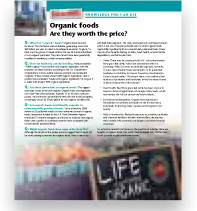CONTENTS
|
PART 5 Plant Life |
|
|
How plants function, and why we need them |
|
|
Three basic tissue types give rise to diverse plant characteristics. 688 |
|
|
17.1 |
Older, taller, bigger: plants are extremely diverse (but share a basic structural organization). 688 |
|
17.2 |
Flowering plants are divided into two major groups: the monocots and the eudicots. 690 |
|
17.3 |
Plants are organized into tissues, each with specific functions. 691 |
|
Most plants have common structural features. . 695 |
|
|
17.4 |
Roots anchor the plant and take up water and minerals. 695 |
|
17.5 |
Stems are the backbone of the plant. 697 |
|
17.6 |
Leaves feed the plant. 699 |
|
17.7 |
Several structures help plants resist water loss. 701 |
|
Plant nutrition: plants obtain sunlight and usable chemical elements from the environment. 703 |
|
|
17.8 |
Four factors are necessary for plant growth. 703 |
|
17.9 |
Nutrients cycle from soil to organisms and back again. 704 |
|
17.10 |
Plants acquire essential nitrogen with the help of bacteria. 707 |
|
17.11 |
This is how we do it: Carnivorous plants can consume prey and do photosynthesis. Why are they confined to bogs and other nutrient- |
|
Plants transport water, sugar, and minerals through vascular tissue. 711 |
|
|
17.12 |
Plants take up water and minerals through their roots. 711 |
|
17.13 |
Water and minerals are distributed through the xylem. 713 |
|
17.14 |
Sugar and other nutrients are distributed through the phloem. 716 |
|
Organic foods: are they worth the price? 718 |
|
XXI
 17 • Plant Structure and and Nutrient Support 687
17 • Plant Structure and and Nutrient Support 687 StreetBIO: KNOWLEDGE YOU CAN USE
StreetBIO: KNOWLEDGE YOU CAN USE